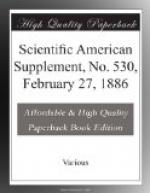But even in this latter respect there is a maximum for receivers, as I have already pointed out that there is for iron filings transmitters. For a magnetic field of given intensity, there is, all things equal, a diaphragm thickness that gives a maximum telephonic result. Such result, which is analogous to those that occur in other electro-magnetic phenomena, may explain the want of success of many tentatives made somewhat at haphazard, with a view to increasing the intensity of telephonic effects.
* * * * *
DECOMPOSITION AND FERMENTATION OF MILK.
Dr. F. Hueppe, who has paid great attention to this subject, describes five distinct organisms which he finds to be invariable accompaniments of lactic fermentation. One of these he isolated on nutrient gelatine in the form of white, shining, flat, minute beads. This organism has the power of transforming milk sugar and other saccharoses into lactic acid, with evolution of carbonic acid gas. It is rarely found in the saliva or mucilage of the teeth. In these are two micrococci, both of which cause the production of lactic acid, but which manifest differences in their development under cultivation. There are also two pigment forming bacteria, Micrococcus prodigiosus, which produces intensely red spots, and the yellow micrococcus of osteomyelitis. These five bacteria are so different and so constant in their properties that they must, in Dr. Hueppe’s opinion, be regarded as distinct species. In addition to them there is in milk an organism resembling Mycoderma aceti, which transforms milk sugar into gluconic acid.
* * * * *
THE NEW “BURGTHEATER” IN VIENNA.
At last the new “Burgtheater” in Vienna is completed. We say “at last,” for work was begun on this new theater more than ten years ago. One after another, monumental architectural works have been erected, which are no less grand and beautiful than this. They were finished long ago, and given over to their respective uses—the Parliament buildings, the “Rathhaus,” the University; but Baron Hasenauer, who had charge of the construction of this building, as well as of many others, could not bring himself to the quicker tempo of Messrs Hansen, Schmid, and Ferstel. The citizens of Vienna were naturally impatient to see their beautiful “Ringstrasse” completed, and only the Hasenauer buildings were needed to make it perfect.
[Illustration: THE NEW IMPERIAL PALACE THEATRE, VIENNA. ORIGINAL DESIGN BY J.J. KIRCHNER.]
The building was built according to the plans of Semper and Hasenauer; for, as in the other great buildings erected by Hasenauer, the new palace and the museums, Semper’s plans served as a foundation. All the modern improvements in the architecture of theaters have been embodied in the new theater, for the terrible catastrophe at the Ringtheater taught a lesson which has not been forgotten, and the greatest care has been taken to guard against fire.




